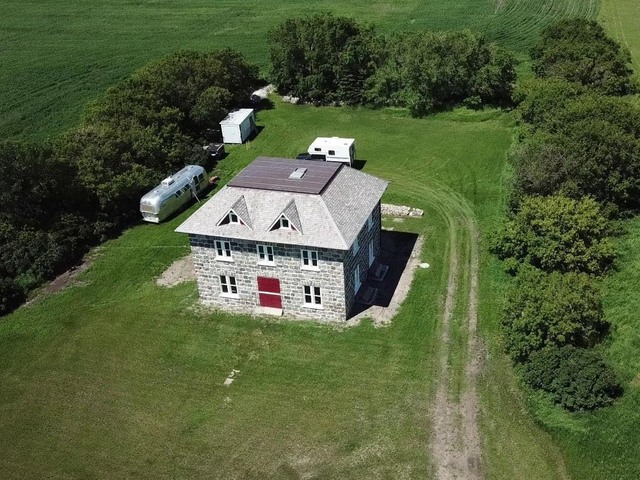Had it been a normal year, we would be working hard preparing for our Lieutenant Governor of Saskatchewan Heritage Awards. COVID-19 had other plans, however, and like many events, it was cancelled. Because the Awards are not far from our hearts and minds, we've decided to catch up with some past winners to see how their initiatives have evolved since their nomination took place. Today, we are featuring an interview with Richard Krehbiel, who owns and manages the Smithfield Heritage Restoration Project in Kisbey. This project won the Physical Heritage Conservation Award in 2019.
Q: Since winning the 2019 Lieutenant Governor of Saskatchewan Heritage Award for Physical Heritage Conservation, what updates has the Smithfield House seen?
A: With some much-appreciated support from the Saskatchewan Heritage Foundation, I’m working at the moment to complete some finishing work and repointing around the windows and doors. I’m also doing some stonework in the basement where a bearing wall was damaged when the heating was converted to oil in the 1970s. I was invited to salvage several interior doors and trim from a local house that was being demolished and continue to work on researching the domestic history of the house and its inhabitants. A young couple from the Shiloh military base camped onsite for a weekend and scanned the yard with metal detectors. I planted some trees in the shelterbelt, which is getting a bit decadent, and kept the grounds mowed over the summer.
Q: What originally motivated you to renovate the Smithfield House?
A: There was actually no single decision point, so it is difficult to isolate the ultimate motivation. I originally intended only to find out “whatever happened to Smithfield?” because we had no family left in the area after 1971 and had gradually lost touch with it other than knowing it was deteriorating. But after researching family and public records and visiting the site in 2005, I thought that I could at least try to prevent further decay so for the next ten years I returned for a week or so each summer to clean up and stabilize the house, which was the last remaining building of the original large scale operation. At that point, it was essentially a summer hobby. But by the time my daughter graduated from high school in 2015 and I was in a position to consider partial retirement, it had evolved into a decision to relocate to the area and do what I could to restore it.
As to what motivated me throughout this progression, I suppose it started with simple historical curiosity, which became a relaxing seasonal diversion and finally a deeper commitment to try and restore the structure. The common theme that connects those steps was, I think, a desire to preserve the memory of our family’s most lasting physical contribution and to re-connect the extended family in a way that was grounded in our history. I am the eldest in my generation and accept some responsibility in which regard I was strongly encouraged by my late mother’s lifelong commitment to the family and its history.
There was also an element of wanting our ancestors and their efforts not to be forgotten, and if I am to be entirely honest, a desire to leave a visible personal legacy.
Since that time, the social narrative has changed significantly, and it seems even more important to protect and defend this aspect of Saskatchewan’s history.
Q: How has living heritage influenced the restoration process of the house?
A: There are several layers to this. My grandfather was born in Scotland but grew up at Smithfield and after returning from World War I, managed the operation until his marriage in 1924. He and two other children of the house ultimately relocated to the Nipawin area where I grew up, so Smithfield was a topic of family conversation for as long as I can remember. This involved not only the stone construction, which was a wonder to us frame- and log-house dwellers, but it was also the locus for a legacy of Scottish folklore, music, and colourful family characters. My grandfather also influenced his family through his dedication to natural resources conservation and community service, and it was in that spirit that I was drawn back to Smithfield in 2004-05.
While that personal theme is still strong, it also ties into the living heritage of the rural community where Smithfield is situated. Our family was well-known and influential, so there are many inter-relationships and documented and undocumented stories that exist from their time (1890 through 1971), as well as from the subsequent tenant families who lived in Smithfield until it was vacated in 1988. Interestingly, the preservation and restoration work has acted as a “prompt” to revive and focus many local memories and stories that might otherwise have been lost.
The project has also re-established connections with the descendants of individuals who immigrated from Scotland and elsewhere to work at Smithfield in its glory days, at least three of whom went on to establish their own family lines in Saskatchewan. These connections, mainly in agriculture are mutually helpful in preserving other family histories and folklore.
Q: Why do you think it is important for individuals to undertake restoration projects like this in Saskatchewan?
A: The easy answer is because it’s the right thing to do. Many countries in the world understand this but Canada’s built heritage preservation and restoration regime is still in a primitive and vulnerable state, so it is necessary to look beyond the easy answer.
Certainly, there is a complex interplay of financial cost, shortage of public support, competing economic interests and many other barriers. On the other hand, there is a range of practical benefits such as the comparative costs of restoration versus new construction, carbon sequestration, construction waste reduction, local economic contribution, etc. But beyond those pragmatic considerations I suggest as follows:
- In the absence of comprehensive public policy and legislation, the responsibility to preserve and restore must necessarily be led by private individuals.
- People are largely defined by our places. They reflect who we are and can show us how we became that way. From there, we can better establish connections and navigate the future.
- Canada does not have a strong built heritage ethic and is the poorer for that. Preservation, restoration, and renovation projects can help build the appreciation necessary to advance that core value.
- Old buildings provide a tangible representation of continuity between past, present and future that helps to centre us, particularly in this current period of polarization and cultural challenge.
- Rural heritage buildings preserve a connection to a practical land ethic that is becoming more difficult to sustain in an increasingly urbanized society. The stability and perspective that open, productive spaces provide could have considerable social utility in a time of shifting narratives and uncertain values.
- As noted above, a heritage building can provide the anchor point for diverse threads of tangible and intangible heritage that make up the layered web of our collective history.
Q: Have you heard of other projects comparable to the Smithfield House taking place in the province since you’ve started this restoration project?
A: None that I know of in Saskatchewan, although I participate in several Facebook built heritage groups and am aware of one or two similar stone house restoration projects in Manitoba.
Q: What are your plans for this space going forward?
A: That is as yet an open question. At the very least, I would like it to be habitable as a seasonal or occasional residence. Beyond that, I understand preservation for the sake of preservation alone is not always viable, so I am considering various options to commercialize the building for future utility. Bed and breakfast has been suggested as well as a tea house, but these may be limited by location. I am also interested in the feasibility of some sort of research institute, document centre or training facility and I would be pleased to entertain other suggestions!
Thank you to Richard Krehbiel for his thoughtful and insightful answers about this project and the state of built heritage conservation in Canada. Check back to our Blog for interviews with other past Award winners!
Addendum October 5, 2020: Check out the video and article by CTV Regina featuring Richard and the Smithfiled House


